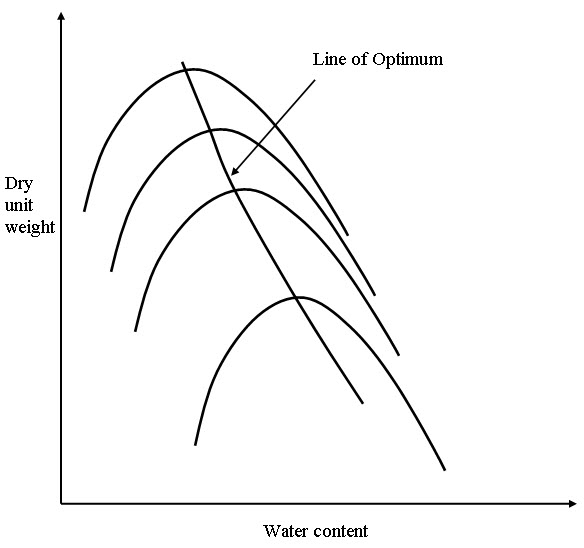Site pages
Current course
Participants
General
MODULE 1. Fundamentals of Soil Mechanics
MODULE 2. Stress and Strength
MODULE 3. Compaction, Seepage and Consolidation of...
MODULE 4. Earth pressure, Slope Stability and Soil...
Keywords
29 March - 4 April
5 April - 11 April
12 April - 18 April
19 April - 25 April
26 April - 2 May
LESSON 15. Factors Affecting Compaction
15.1 Factors affecting compaction
The compaction of soil depends on the following factors:
-
Water content
-
Compactive effort
-
Type of soil
-
Method of compaction
Water content: Water content has significant effect on compaction characteristics of soil. At low water content, soil is stiff and soil grains offer more resistance to compaction. As the water content increases, water films are formed around the soil grains and water around the soil grains act as lubricant. Due to this, soil grains come close to each other and make a dense configuration. At optimum moisture content, soil reaches the maximum unit weight as lubrication effect is the maximum at this stage. Further addition of more water replaces the soil grains. Thus, addition of more water after optimum moisture content reduces the unit weight as unit weight of water is less than the unit weight of soil grains. Because of the due to the addition of water dry unit weight of soil increases upto a certain water content value (OMC) and beyond that addition of more water decreases the dry unit weight of soil (as shown in Figure 15.1). This can be also explained by concept of soil structure and electrical double layer theory.

Fig.15.1. Compaction curves for clay.
Compactive effort: As the compactive effort increases maximum dry unit weight increases in a decreasing rate. However, the OMC value decreases as the compactive effort increases. Thus, if the compactive effort increases the compaction curve is shifted to the top and to the left side as shown in Figure 15.2. However, as the water content increases the effect of compactive effort on dry unit weight decreases. If the peaks of the compaction curves for different compactive efforts are joined the obtained line is called line of optimum (as shown in Figure 15.2). The line of optimum is nearly parallel to line of zero air voids. Thus, the efficiency of the compaction does not increase as the compactive effort increases.

Fig.15.2. Effect of compactive effort.
Type of soil: Soil type has significant effect on compaction. It is observed that cohesive soil has higher OMC value and poorly graded sands have lower dry unit weight as compared to the coarse-grained, well graded soil with some percentage of fines. However, excessive amount of fines reduces the maximum dry unit weight value of the soil. Maximum dry unit weight of sand is obtained either completely dry or saturated condition. Compaction curve has very little importance in case of sandy soils.
Method of compaction: It is observed that mode of compaction influences the shape of compaction curves. The shape of compaction curves for standard proctor test and modified proctor test are some what different. The shape of the compaction curve obtained from laboratory tests and obtained from field by various compactive methods are also different.
References
Ranjan, G. and Rao, A.S.R. (2000). Basic and Applied Soil Mechanics. New Age International Publisher, New Delhi, India.
PPT of Professor N. Sivakugan, JCU, Australia.
Suggested Readings
Ranjan, G. and Rao, A.S.R. (2000) Basic and Applied Soil Mechanics. New Age International Publisher, New Delhi, India.
Arora, K.R. (2003) Soil Mechanics and Foundation Engineering. Standard Publishers Distributors, New Delhi, India.
Murthy V.N.S (1996) A Text Book of Soil Mechanics and Foundation Engineering, UBS Publishers’ Distributors Ltd. New Delhi, India.
PPT of Professor N. Sivakugan, JCU, Australia (www.kau.edu.sa/Files/0001553/files/33763_Compaction-Sivakugan.ppt).